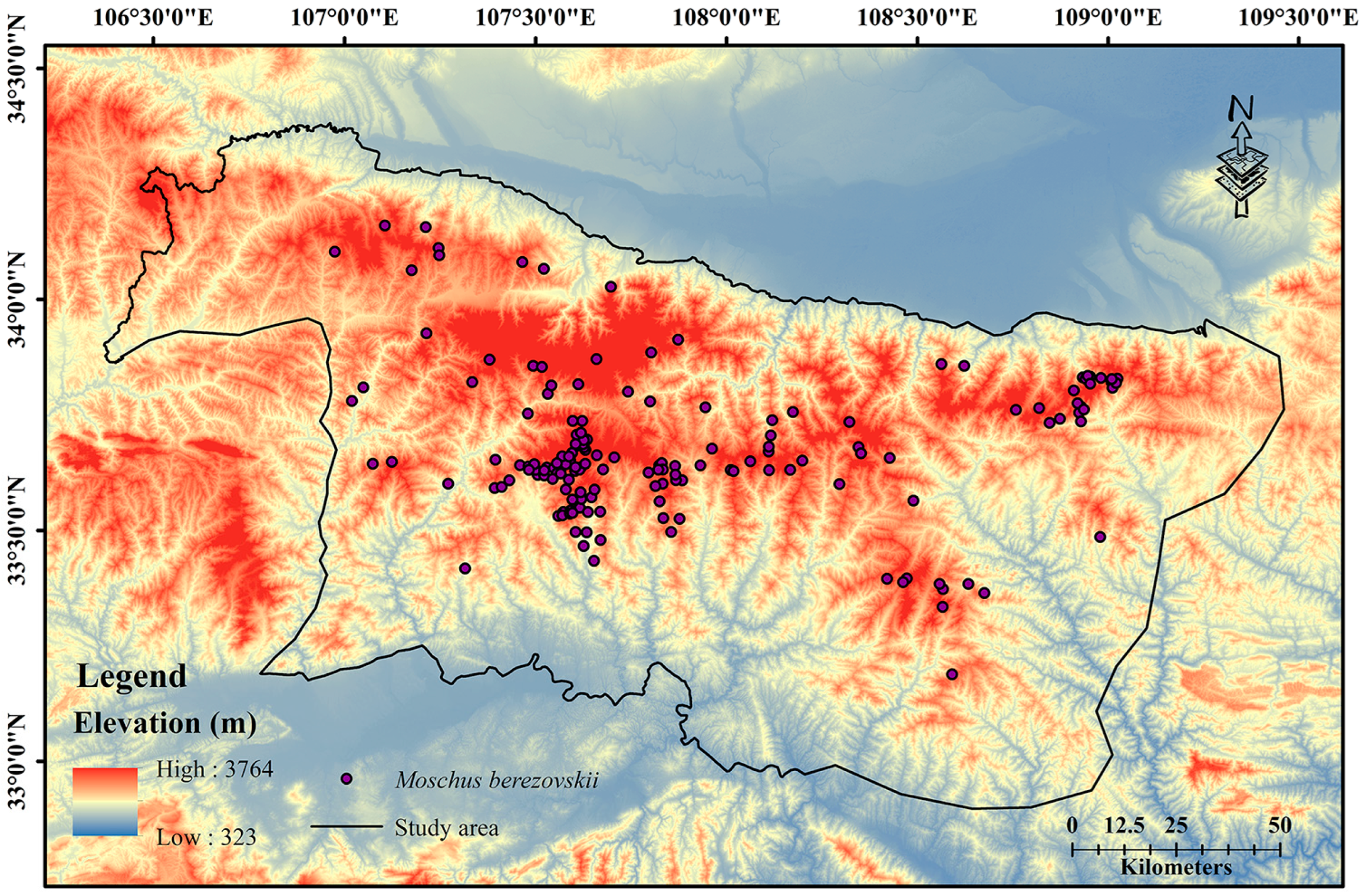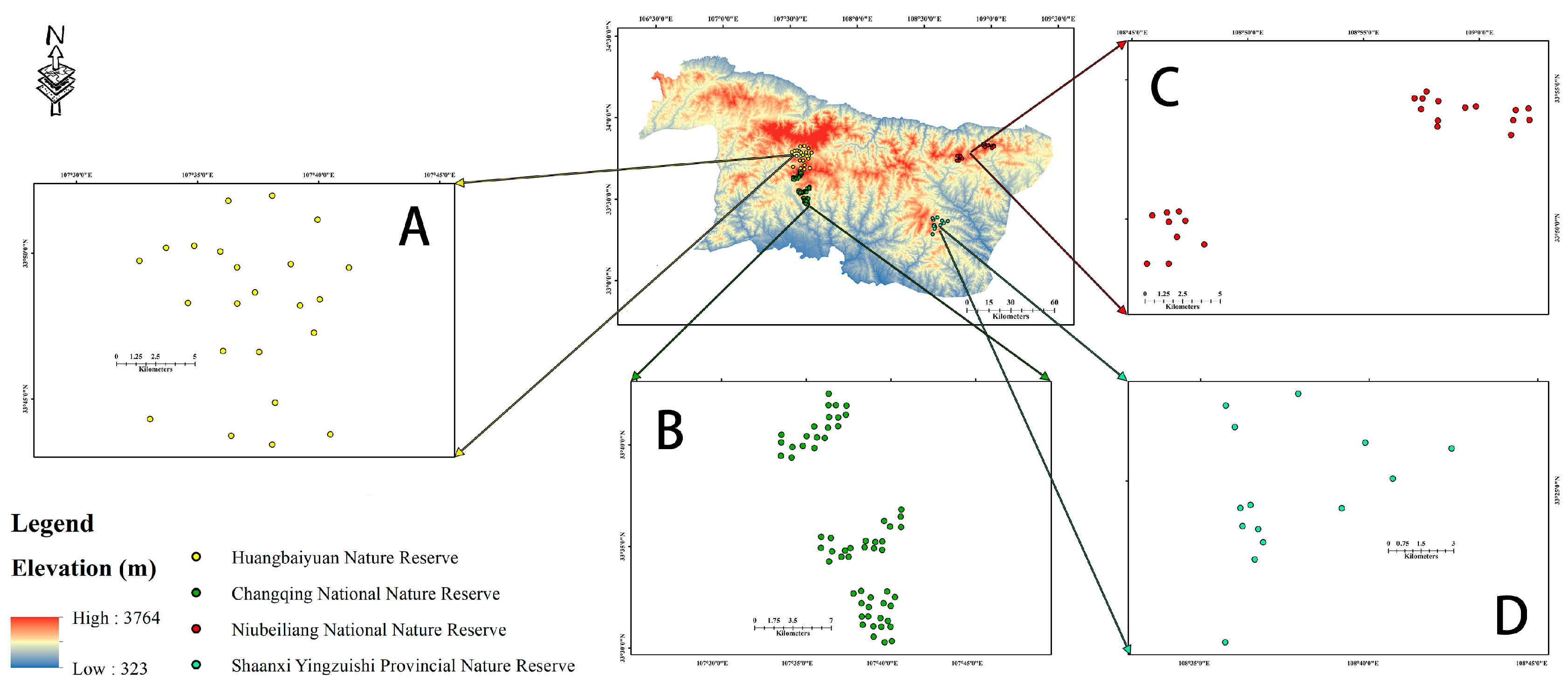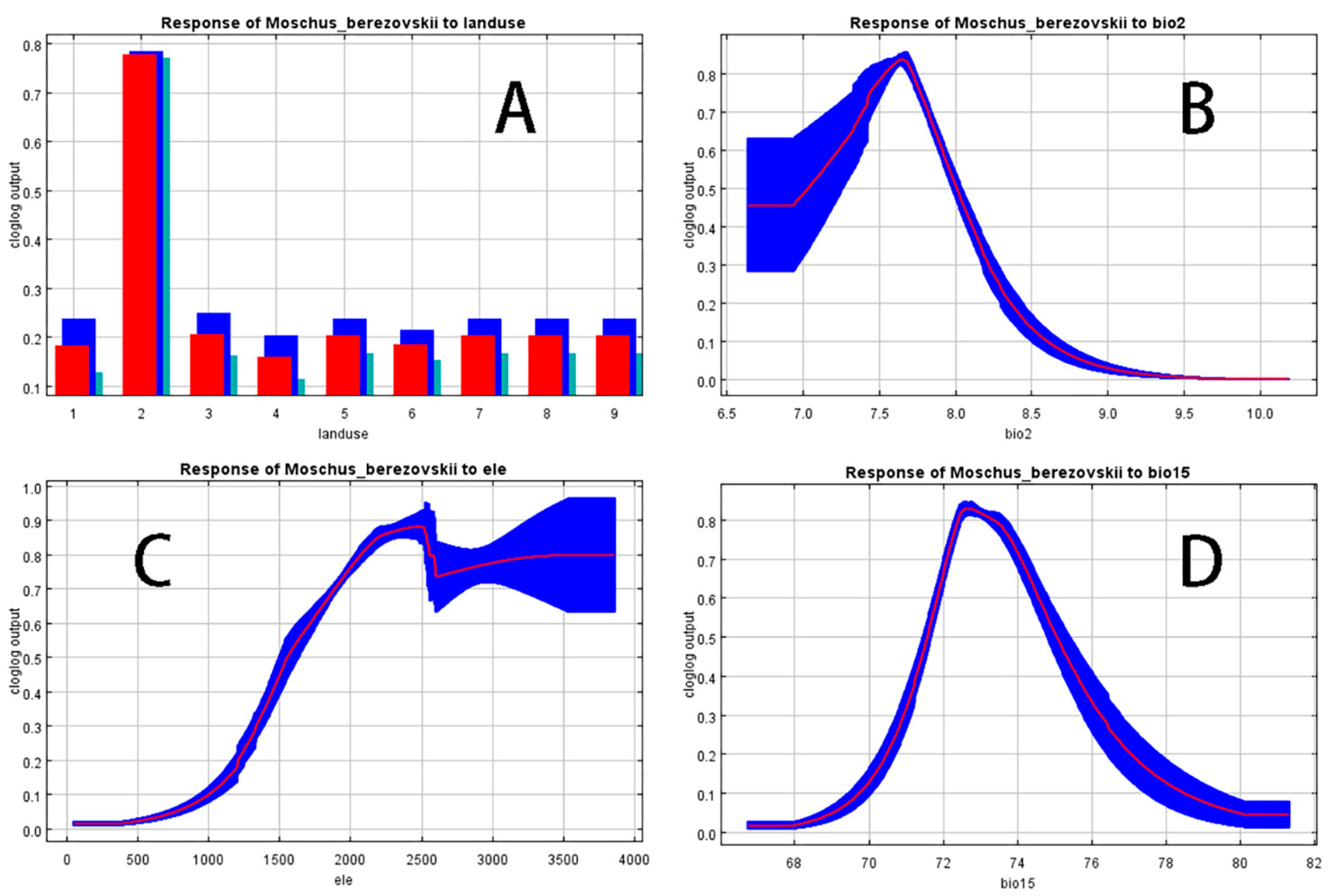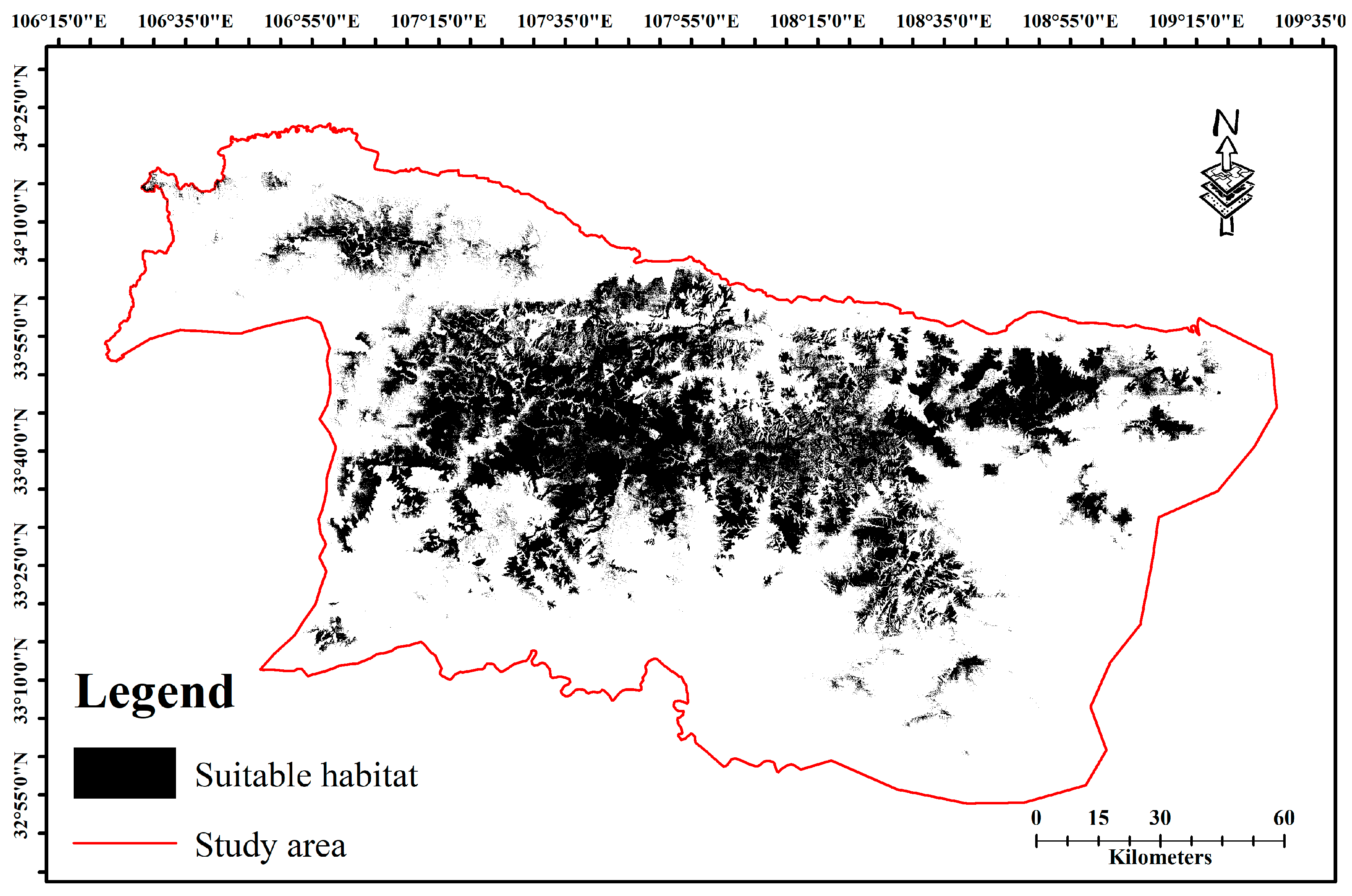Integrating Species Distribution Models to Estimate the Population Size of Forest Musk Deer (Moschus berezovskii) in the Central Qinling Mountains of Shaanxi
Abstract
:1. Introduction
2. Materials and Methods
2.1. Research Area
2.2. Species Distribution Model
2.2.1. Forest Musk Deer Occurrence Data
2.2.2. Environmental Variable Data
2.2.3. Model Evaluation
2.3. Estimation of Forest Musk Deer Population
2.3.1. Camera Traps Survey
2.3.2. Estimation of Forest Musk Deer Population Density in the Survey Area
2.3.3. Model Accuracy Assessment
2.3.4. Integrating Density Estimation with the Species Distribution Model
3. Results
3.1. Species Distribution Model
3.2. Population Estimation
3.2.1. Camera Traps Method
3.2.2. Model Accuracy Estimation
3.2.3. Integration of Density Estimation and Species Distribution Model
4. Discussion
4.1. Species Distribution Model
4.2. Population Size Estimation
4.3. Management Recommendation
Supplementary Materials
Author Contributions
Funding
Institutional Review Board Statement
Data Availability Statement
Acknowledgments
Conflicts of Interest
References
- Fan, Z.; Li, W.; Jin, J.; Cui, K.; Yan, C.; Peng, C.; Jian, Z.; Bu, P.; Price, M.; Zhang, X.; et al. The draft genome sequence of forest musk deer (Moschus berezovskii). Gigascience 2018, 7, giy038. [Google Scholar] [CrossRef] [PubMed]
- Cai, R.; Shafer, A.B.A.; Laguardia, A.; Lin, Z.; Liu, S.; Hu, D. Recombination and selection in the major histocompatibility complex of the endangered forest musk deer (Moschus berezovskii). Sci. Rep. 2015, 5, 17285. [Google Scholar] [CrossRef] [PubMed]
- Tran, D.V.; Viet, D.P.; Tien, T.V.; Nguyen, A.; Van, C.P.; Tilker, A. New records of the forest musk deer Moschus berezovskii in Viet Nam revealed by camera traps. Oryx 2021, 55, 494–495. [Google Scholar] [CrossRef]
- Yang, Q.; Meng, X.; Xia, L.; Feng, Z. Conservation status and causes of decline of musk deer (Moschus spp.) in China. Biol. Conserv. 2003, 109, 333–342. [Google Scholar] [CrossRef]
- Sun, X.; Cai, R.; Jin, X.; Shafer, A.B.A.; Hu, X.; Yang, S.; Li, Y.; Qi, L.; Liu, S.; Hu, D. Blood transcriptomics of captive forest musk deer (Moschus berezovskii) and possible associations with the immune response to abscesses. Sci. Rep. 2018, 8, 599. [Google Scholar] [CrossRef] [PubMed]
- Wen, R.S. The Distributions and Changes of Rare Wild Animals in China (Sequel); Shandong Science and Technology Press: Jinan, China, 2018; pp. 740–741. [Google Scholar]
- Wang, Y.; Harris, R. Moschus berezovskii. The IUCN Red List of Threatened Species 2015; IUCN Red List: Cambridge, UK, 2015. [Google Scholar]
- Gao, Y.; Duszynski, D.W.; Yuan, F.; Hu, D.; Zhang, D. Coccidian parasites in the endangered forest musk deer (Moschus berezovskii) in China, with the description of six new species of Eimeria (Apicomplexa: Eimeriidae). Parasite 2021, 28, 70. [Google Scholar] [CrossRef]
- Noon, B.R.; Bailey, L.L.; Sisk, T.D.; Mckelvey, K.S. Efficient Species-Level Monitoring at the Landscape Scale. Conserv. Biol. 2012, 26, 432–441. [Google Scholar] [CrossRef]
- Morin, D.J.; Boulanger, J.; Bischof, R.; Lee, D.C.; Ngoprasert, D.; Fuller, A.K.; McLellan, B.; Steinmetz, R.; Sharma, S.; Garshelis, D.; et al. Comparison of methods for estimating density and population trends for low-density asian bears. Glob. Ecol. Conserv. 2022, 35, e2058. [Google Scholar] [CrossRef]
- Legault, A.; Theuerkauf, J.; Chartendrault, V.; Rouys, S.; Saoumoé, M.; Verfaille, L.; Desmoulins, F.; Barré, N.; Gula, R. Using ecological niche models to infer the distribution and population size of parakeets in New Caledonia. Biol. Conserv. 2013, 167, 149–160. [Google Scholar] [CrossRef]
- Pagel, J.; Anderson, B.J.; Ohara, R.B.; Cramer, W.; Fox, R.C.; Jeltsch, F.; Roy, D.B.; Thomas, C.D.; Schurr, F.M. Quantifying range-wide variation in population trends from local abundance surveys and widespread opportunistic occurrence records. Methods Ecol. Evol. 2014, 5, 751–760. [Google Scholar] [CrossRef]
- Hu, Z.; Wang, Y.; Xue, W.; Jiang, H.; Xu, H. Studies on Habitat Selection by Moschus Berezovskii in Winter in Zibaishan Nature Reserve. J. Henan Univ. (Nat. Sci.) 2006, 36, 70–74. [Google Scholar]
- Jiang, H.; Xue, W.; Wang, Y.; Hu, Z.; Xiao, Y. Spring Habitat Selection of Forest Musk Deer (Moschus berezovskii) in Fengxian County, Shaanxi Province. Sichuan J. Zool. 2008, 27, 115–119. [Google Scholar]
- Anile, S.; Ragni, B.; Randi, E.; Mattucci, F.; Rovero, F. Wildcat population density on the Etna volcano, Italy: A comparison of density estimation methods. J. Zool. 2014, 293, 252–261. [Google Scholar] [CrossRef]
- Bessone, M.; Kühl, H.S.; Hohmann, G.; Herbinger, I.; N’Goran, K.P.; Asanzi, P.; Da Costa, P.B.; Dérozier, V.; Fotsing, E.D.B.; Beka, B.I.; et al. Drawn out of the shadows: Surveying secretive forest species with camera trap distance sampling. J. Appl. Ecol. 2020, 57, 963–974. [Google Scholar] [CrossRef]
- Zwerts, J.A.; Stephenson, P.J.; Maisels, F.; Rowcliffe, M.; Astaras, C.; Jansen, P.A.; Waarde, J.; Sterck, L.E.H.M.; Verweij, P.A.; Bruce, T.; et al. Methods for wildlife monitoring in tropical forests: Comparing human observations, camera traps, and passive acoustic sensors. Conserv. Sci. Pract. 2021, 3, 1. [Google Scholar] [CrossRef]
- Bohnett, E.; Poya Faryabi, S.; Lewison, R.; An, L.; Bian, X.; Rajabi, A.M.; Jahed, N.; Rooyesh, H.; Mills, E.; Ramos, S.; et al. Human expertise combined with artificial intelligence improves performance of snow leopard camera trap studies. Glob. Ecol. Conserv. 2023, 41, e2350. [Google Scholar] [CrossRef]
- Rich, L.N.; Miller, D.A.W.; Muñoz, D.J.; Robinson, H.S.; McNutt, J.W.; Kelly, M.J. Sampling design and analytical advances allow for simultaneous density estimation of seven sympatric carnivore species from camera trap data. Biol. Conserv. 2019, 233, 12–20. [Google Scholar] [CrossRef]
- Zero, V.H.; Sundaresan, S.R.; O’Brien, T.G.; Kinnaird, M.F. Monitoring an Endangered savannah ungulate, Grevy’s zebra Equus grevyi: Choosing a method for estimating population densities. Oryx 2013, 47, 410–419. [Google Scholar] [CrossRef]
- Santini, G.; Abolaffio, M.; Ossi, F.; Franzetti, B.; Cagnacci, F.; Focardi, S. Population assessment without individual identification using camera-traps: A comparison of four methods. Basic. Appl. Ecol. 2022, 61, 68–81. [Google Scholar] [CrossRef]
- Moeller, A.K.; Lukacs, P.M.; Horne, J.S. Three novel methods to estimate abundance of unmarked animals using remote cameras. Ecosphere 2018, 9, e2331. [Google Scholar] [CrossRef]
- National Forestry and Grassland Administration. Investigation on Major Terrestrial Wildlife Resources in China; China Forestry Publishing House: Beijing, China, 2009; pp. 282–283. [Google Scholar]
- Zhang, Y.; Li, F.; Li, K.; Sun, L.; Yang, H. The Influence of Space Transformation of Land Use on Function Transformation and the Regional Differences in Shaanxi Province. Int. J. Environ. Res. Public Health 2022, 19, 11793. [Google Scholar] [CrossRef] [PubMed]
- Li, J.; Ren, Z.; Zhou, Z. Ecosystem services and their values: A case study in the Qinba mountains of China. Ecol. Res. 2006, 21, 597–604. [Google Scholar] [CrossRef]
- Wang, B.; Xu, G.; Li, P.; Li, Z.; Zhang, Y.; Cheng, Y.; Jia, L.; Zhang, J. Vegetation dynamics and their relationships with climatic factors in the Qinling Mountains of China. Ecol. Indic. 2020, 108, 105719. [Google Scholar] [CrossRef]
- Gong, M.; Fan, Z.; Wang, J.; Liu, G.; Lin, C. Delineating the ecological conservation redline based on the persistence of key species: Giant pandas (Ailuropoda melanoleuca) inhabiting the Qinling Mountains. Ecol. Model. 2017, 345, 56–62. [Google Scholar] [CrossRef]
- Hu, J.; Jiang, Z. Climate Change Hastens the Conservation Urgency of an Endangered Ungulate. PLoS ONE 2011, 6, e22873. [Google Scholar] [CrossRef]
- Buonincontri, M.P.; Bosso, L.; Smeraldo, S.; Chiusano, M.L.; Pasta, S.; Di Pasquale, G. Shedding light on the effects of climate and anthropogenic pressures on the disappearance of Fagus sylvatica in the Italian lowlands: Evidence from archaeo-anthracology and spatial analyses. Sci. Total Environ. 2023, 877, 162893. [Google Scholar] [CrossRef]
- Taylor, A.; Sigona, A.; Kelly, M. Modeling spatial distributions of Amah Mutsun priority cultural plants to support Indigenous cultural revitalization. Ecosphere 2023, 14, e4374. [Google Scholar] [CrossRef]
- Engler, J.O.; Stiels, D.; Schidelko, K.; Strubbe, D.; Quillfeldt, P.; Brambilla, M. Avian SDMs: Current state, challenges, and opportunities. J. Avian Biol. 2017, 48, 1483–1504. [Google Scholar] [CrossRef]
- Guisan, A.; Thuiller, W. Predicting species distribution: Offering more than simple habitat models. Ecol. Lett. 2005, 8, 993–1009. [Google Scholar] [CrossRef]
- Phillips, S.J.; Anderson, R.P.; Schapire, R.E. Maximum entropy modeling of species geographic distributions. Ecol. Model. 2006, 190, 231–259. [Google Scholar] [CrossRef]
- Ahmadi, M.; Hemami, M.; Kaboli, M.; Shabani, F. MaxEnt brings comparable results when the input data are being completed; Model parameterization of four species distribution models. Ecol. Evol. 2023, 13, e9827. [Google Scholar] [CrossRef] [PubMed]
- Emad, K.; Victoria, N.; Abdulaziz, A.; Francis, G. A comparison between Ensemble and MaxEnt species distribution modelling approaches for conservation: A case study with Egyptian medicinal plants. Ecol. Inf. Inform. 2020, 60, 101150. [Google Scholar]
- Zhang, Y.; Chen, P. Distribution and Conservation of Moschus berezovskii in Changqing National Nature Reserve. Shaanxi For. Sci. Technol. 2013, 3, 28–30. [Google Scholar]
- Luo, C.; Xu, W.; Zhou, Z.; Ouyang, Z.; Zhang, L. Habitat prediction for forest musk deer (Moschus berezovskii) in Qinling mountain range based on niche model. Acta Ecol. Sin. 2011, 31, 1221–1229. [Google Scholar]
- Liu, J.; Wang, Y.; Bian, K.; Tang, J.; Wang, W.; Guo, L.; Wang, B.; Fang, G.; Zhao, L.; Qi, X. Home range utilization and individual dispersal of re-introduced forest musk deer (Moschus berezovskii). Acta Theriol. Sin. 2020, 40, 109–119. [Google Scholar]
- Alain, F.Z.; Elena, N.I.; Chris, S.E. A protocol for data exploration to avoid common statistical problems. Methods Ecol. Evol. 2010, 1, 3–14. [Google Scholar]
- Sun, X.; Long, Z.; Jia, J. A multi-scale Maxent approach to model habitat suitability for the giant pandas in the Qionglai mountain, China. Glob. Ecol. Conserv. 2021, 30, e1766. [Google Scholar] [CrossRef]
- Kass, J.M.; Muscarella, R.; Galante, P.J.; Bohl, C.L.; Pinilla-Buitrago, G.E.; Boria, R.A.; Soley-Guardia, M.; Anderson, R.P. ENMeval 2.0: Redesigned for customizable and reproducible modeling of species’ niches and distributions. Methods Ecol. Evol. 2021, 12, 1602–1608. [Google Scholar] [CrossRef]
- Ohashi, H.; Hasegawa, T.; Hirata, A.; Fujimori, S.; Takahashi, K.; Tsuyama, I.; Nakao, K.; Kominami, Y.; Tanaka, N.; Hijioka, Y.; et al. Biodiversity can benefit from climate stabilization despite adverse side effects of land-based mitigation. Nat. Commun. 2019, 10, 5240. [Google Scholar] [CrossRef]
- Phillips, S.J.; Anderson, R.P.; Dudík, M.; Schapire, R.E.; Blair, M.E. Opening the black box: An open-source release of Maxent. Ecography 2017, 40, 887–893. [Google Scholar] [CrossRef]
- Ali, H.; Din, J.U.; Bosso, L.; Hameed, S.; Kabir, M.; Younas, M.; Nawaz, M.A. Expanding or shrinking? range shifts in wild ungulates under climate change in Pamir-Karakoram mountains, Pakistan. PLoS ONE 2021, 16, e0260031. [Google Scholar] [CrossRef]
- Martínez-Díaz, M.G.; Reef, R. A biogeographical approach to characterizing the climatic, physical and geomorphic niche of the most widely distributed mangrove species, Avicennia marina. Divers. Distrib. 2023, 29, 89–108. [Google Scholar] [CrossRef]
- Halvorsen, R.; Mazzoni, S.; Dirksen, J.W.; Næsset, E.; Gobakken, T.; Ohlson, M. How important are choice of model selection method and spatial autocorrelation of presence data for distribution modelling by MaxEnt? Ecol. Model. 2016, 328, 108–118. [Google Scholar] [CrossRef]
- ALLOUCHE, O.; TSOAR, A.; KADMON, R. Assessing the accuracy of species distribution models: Prevalence, kappa and the true skill statistic (TSS): Assessing the accuracy of distribution models. J. Appl. Ecol. 2006, 43, 1223–1232. [Google Scholar] [CrossRef]
- Rowcliffe, J.M.; Kays, R.; Kranstauber, B.; Carbone, C.; Jansen, P.A.; Fisher, D. Quantifying levels of animal activity using camera trap data. Methods Ecol. Evol. 2014, 5, 1170–1179. [Google Scholar] [CrossRef]
- Qi, W.; Li, J.; Zhang, X.; Wang, Z.; Li, X.; Yang, C.; Fu, W.; Yue, B. The reproductive performance of female Forest musk deer (Moschus berezovskii) in captivity. Theriogenology 2011, 76, 874–881. [Google Scholar] [CrossRef] [PubMed]
- Yang, X.; Gao, Z.; Wang, L.; Xiao, L.; Dong, N.; Wu, H.; Li, S. Projecting the potential distribution of ticks in China under climate and land use change. Int. J. Parasitol. 2021, 51, 749–759. [Google Scholar] [CrossRef]
- Liu, Z.; Zhao, X.; Wei, W.; Hong, M.; Zhou, H.; Tang, J.; Zhang, Z. Predicting range shifts of the giant pandas under future climate and land use scenarios. Ecol. Evol. 2022, 12, e9298. [Google Scholar] [CrossRef]
- Hu, Z.; Wang, Y.; Xue, W.; Jiang, H.; Xu, H. Population density of Moschus berezovskii in Zibaishan Nature Reserve. J. Zhejiang For. Coll. 2007, 24, 65–71. [Google Scholar]
- Pfeffer, S.E.; Spitzer, R.; Allen, A.M.; Hofmeester, T.R.; Ericsson, G.; Widemo, F.; Singh, N.J.; Cromsigt, J.P.G.M.; Sveriges, L.; Rowcliffe, M.; et al. Pictures or pellets? Comparing camera trapping and dung counts as methods for estimating population densities of ungulates. Remote Sens. Ecol. Con 2018, 4, 173–183. [Google Scholar] [CrossRef]
- Jiang, T. Estimated population of forest musk deer in Shaanxi Province. J. Shaanxi Norm. Univ. Nat. Sci. Ed. 1997, 25, 127–130. [Google Scholar]
- Jamieson, I.G.; Allendorf, F.W. How does the 50/500 rule apply to MVPs? Trends Ecol. Evol. 2012, 27, 578–584. [Google Scholar] [CrossRef] [PubMed]
- Frankham, R. Effective population size/adult population size ratios in wildlife: A review. Genet. Res. 1995, 66, 95–107. [Google Scholar] [CrossRef]
- Zeng, Q.; Zhang, Y.; Sun, G.; Duo, H.; Wen, L.; Lei, G. Using Species Distribution Model to Estimate the Wintering Population Size of the Endangered Scaly-Sided Merganser in China. PLoS ONE 2015, 10, e0117307. [Google Scholar] [CrossRef]





| Survey Area | Area (km2) | Population Density of Forest Musk Deer (Individuals/km2) |
|---|---|---|
| Huangbaiyuan Nature Reserve | 98 | 0.6064 ± 0.1375 |
| Changqing National Nature Reserve | 60 | 0.2977 ± 0.1054 |
| Niubeiliang National Nature Reserve | 35 | 0.3197 ± 0.1305 |
| Shaanxi Yingzuishi Provincial Nature Reserve | 18 | 0.2399 ± 0.0900 |
Disclaimer/Publisher’s Note: The statements, opinions and data contained in all publications are solely those of the individual author(s) and contributor(s) and not of MDPI and/or the editor(s). MDPI and/or the editor(s) disclaim responsibility for any injury to people or property resulting from any ideas, methods, instructions or products referred to in the content. |
© 2023 by the authors. Licensee MDPI, Basel, Switzerland. This article is an open access article distributed under the terms and conditions of the Creative Commons Attribution (CC BY) license (https://creativecommons.org/licenses/by/4.0/).
Share and Cite
Gao, X.; Bu, S.; Zheng, X. Integrating Species Distribution Models to Estimate the Population Size of Forest Musk Deer (Moschus berezovskii) in the Central Qinling Mountains of Shaanxi. Diversity 2023, 15, 1071. https://doi.org/10.3390/d15101071
Gao X, Bu S, Zheng X. Integrating Species Distribution Models to Estimate the Population Size of Forest Musk Deer (Moschus berezovskii) in the Central Qinling Mountains of Shaanxi. Diversity. 2023; 15(10):1071. https://doi.org/10.3390/d15101071
Chicago/Turabian StyleGao, Xinyu, Shuhai Bu, and Xueli Zheng. 2023. "Integrating Species Distribution Models to Estimate the Population Size of Forest Musk Deer (Moschus berezovskii) in the Central Qinling Mountains of Shaanxi" Diversity 15, no. 10: 1071. https://doi.org/10.3390/d15101071
APA StyleGao, X., Bu, S., & Zheng, X. (2023). Integrating Species Distribution Models to Estimate the Population Size of Forest Musk Deer (Moschus berezovskii) in the Central Qinling Mountains of Shaanxi. Diversity, 15(10), 1071. https://doi.org/10.3390/d15101071






